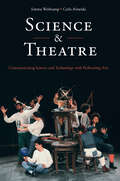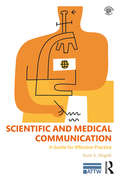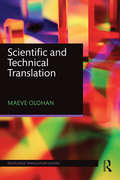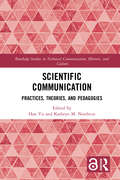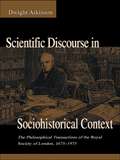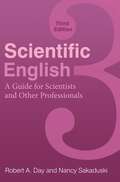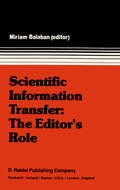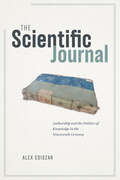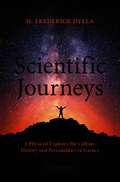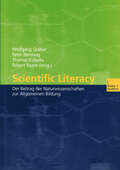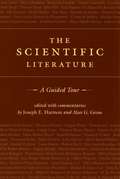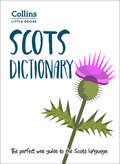- Table View
- List View
Science & Theatre: Communicating Science and Technology with Performing Arts
by Emma Weitkamp Carla AlmeidaThere has been a significant growth in initiatives involving theatre, drama and performance within a science communication context. Yet there is little scholarship exploring this phenomenon from a science communication perspective. Weitkamp and Almeida draw on their distinct experiences with theatre in the context of science communication to delve into initiatives created through dialogue between the arts and the sciences for the purpose of public engagement. Entering into the space where museums, universities and research centres operate, as well as the space of theatre practitioners, they explore the richness and plurality of this universe, combining theory and practice, as well as presenting context, knowledge gaps and new data. Acknowledging that the place of drama, theatre and performance within science communication is one which is uniquely influenced by local cultural practices, discourses and expectations, the authors take a global perspective. Firstly by analysing data from an international survey of practitioners and secondly by curating a collection of case studies on science-theatre projects undertaken around the world. The chapters illustrate the diversity of forms and content that comprises contemporary science-theatre in this context and characterise theatre produced within the scope of science communication, placing it more precisely in the broader context of science-theatre.
Scientific and Medical Communication: A Guide for Effective Practice (ATTW Series in Technical and Professional Communication)
by Scott A. MogullScientific and Medical Communication: A Guide for Effective Practice prepares readers to effectively communicate in professional scientific communities. The material in this book is firmly grounded in more than 500 published research findings and editorials by scientific writers, authors, and journal editors. Thus, this text provides the broadest and most comprehensive analysis of scientific writing. In addition, carefully selected and thoroughly annotated examples from the scientific and medical literature demonstrate the recommendations covered in the text. These real-world examples were carefully selected so that the scientific content can be understood by those without a detailed background in any particular scientific or medical field—thus clearly illustrating the content organization and writing style. This text will prepare individuals to write and edit scientific manuscripts, conference abstracts, posters, and press releases according to journal and professional standards. Readers will also learn to conduct effective searches of the scientific and medical literature, as well as proper citation practices.
Scientific and Medical Communication: A Guide for Effective Practice (ATTW Series in Technical and Professional Communication)
by Scott A. MogullScientific and Medical Communication: A Guide for Effective Practice prepares readers to effectively communicate in professional scientific communities. The material in this book is firmly grounded in more than 500 published research findings and editorials by scientific writers, authors, and journal editors. Thus, this text provides the broadest and most comprehensive analysis of scientific writing. In addition, carefully selected and thoroughly annotated examples from the scientific and medical literature demonstrate the recommendations covered in the text. These real-world examples were carefully selected so that the scientific content can be understood by those without a detailed background in any particular scientific or medical field—thus clearly illustrating the content organization and writing style. This text will prepare individuals to write and edit scientific manuscripts, conference abstracts, posters, and press releases according to journal and professional standards. Readers will also learn to conduct effective searches of the scientific and medical literature, as well as proper citation practices.
Scientific and Technical Translation (Routledge Translation Guides)
by Maeve OlohanRoutledge Translation Guides cover the key translation text types and genres and equip translators and students of translation with the skills needed to translate them. Concise, accessible and written by leading authorities, they include examples from existing translations, activities, further reading suggestions and a glossary of key terms. Scientific and Technical Translation focuses on texts that are typically translated in scientific and technical domains, such as technical instructions, data sheets and brochures, patents, scientific research articles and abstracts, popular science press releases and news reports. In seven chapters, this practical textbook: Introduces readers to the typical contexts in which scientific and technical translators work; Shows how corpus resources can be used for terminological and phraseological research; Considers how translation technologies are employed in technical and scientific translation; Explains a range of technical and scientific genres and their translation. Including a wide range of relevant tasks and activities, examples from the most commonly taught language pairs and a glossary of key terms, this is the essential textbook for modules on scientific and technical translation and specialised translation.
Scientific and Technical Translation (Routledge Translation Guides)
by Maeve OlohanRoutledge Translation Guides cover the key translation text types and genres and equip translators and students of translation with the skills needed to translate them. Concise, accessible and written by leading authorities, they include examples from existing translations, activities, further reading suggestions and a glossary of key terms. Scientific and Technical Translation focuses on texts that are typically translated in scientific and technical domains, such as technical instructions, data sheets and brochures, patents, scientific research articles and abstracts, popular science press releases and news reports. In seven chapters, this practical textbook: Introduces readers to the typical contexts in which scientific and technical translators work; Shows how corpus resources can be used for terminological and phraseological research; Considers how translation technologies are employed in technical and scientific translation; Explains a range of technical and scientific genres and their translation. Including a wide range of relevant tasks and activities, examples from the most commonly taught language pairs and a glossary of key terms, this is the essential textbook for modules on scientific and technical translation and specialised translation.
The Scientific Article in the Age of Digitization (Information Science and Knowledge Management #11)
by John Mackenzie OwenThis book outlines the consequences of digitization for peer-reviewed research articles published in electronic journals. It is argued that digitization will revolutionize scientific communication. However, this study shows that this is not the case where scientific journals are concerned. Authors make little use of the possibilities offered by the digital medium; electronic peer review procedures have not replaced traditional ones, and users have not embraced new forms of interaction offered by some electronic journals.
Scientific Communication: Practices, Theories, and Pedagogies (Routledge Studies in Technical Communication, Rhetoric, and Culture)
by Han Yu Kathryn NorthcutThis book addresses the roles and challenges of people who communicate science, who work with scientists, and who teach STEM majors how to write. In terms of practice and theory, chapters address themes encountered by scientists and communicators, including ethical challenges, visual displays, and communication with publics, as well as changed and changing contexts and genres. The pedagogy section covers topics important to instructors’ everyday teaching as well as longer-term curricular development. Chapters address delivery of rhetorically informed instruction, communication from experts to the publics, writing assessment, online teaching, and communication-intensive pedagogies and curricula.
Scientific Communication: Practices, Theories, and Pedagogies (Routledge Studies in Technical Communication, Rhetoric, and Culture)
by Han Yu Kathryn M. NorthcutThis book addresses the roles and challenges of people who communicate science, who work with scientists, and who teach STEM majors how to write. In terms of practice and theory, chapters address themes encountered by scientists and communicators, including ethical challenges, visual displays, and communication with publics, as well as changed and changing contexts and genres. The pedagogy section covers topics important to instructors’ everyday teaching as well as longer-term curricular development. Chapters address delivery of rhetorically informed instruction, communication from experts to the publics, writing assessment, online teaching, and communication-intensive pedagogies and curricula.
Scientific Discourse in Sociohistorical Context: The Philosophical Transactions of the Royal Society of London, 1675-1975 (Rhetoric, Knowledge, and Society Series)
by Dwight AtkinsonScientific Discourse in Sociohistorical Context represents the intersection of knowledge and method, examined from the perspective of three distinct disciplines: linguistics, rhetoric-composition, and history. Herein, Dwight Atkinson describes the written language and rhetoric of the Royal Society of London, based on his analysis of its affiliated journal, The Philosophical Transactions, starting with the 17th century advent of modern empirical science through to the present day. Atkinson adopts two independent approaches to the analysis of written discourse--from the fields of linguistics and rhetoric-composition--and then integrates and interprets his findings in light of the history of the Royal Society and British science. Atkinson's study provides the most complete and particular institutional account of a scientific journal, which in this case is a publication that stands as an icon of scientific publication. He supplies his readers with important material found nowhere else in the historical literature, including details about the operation of the journal and its relation to the society. The work embeds the history of the journal and its editors within the history of the Royal Society and other developments in science and society. The synthesis of historical, linguistic, rhetorical, and cultural analysis makes visible certain complex communicative dynamics that could not previously be seen from a single vantage point. The work presented here reinforces how deep historical examinations of linguistic and rhetorical practices have direct bearing on how and what scholars read and write now. Most significantly, this volume demonstrates how these historical activities need to inform current teaching of and thinking about language.
Scientific Discourse in Sociohistorical Context: The Philosophical Transactions of the Royal Society of London, 1675-1975 (Rhetoric, Knowledge, and Society Series)
by Dwight AtkinsonScientific Discourse in Sociohistorical Context represents the intersection of knowledge and method, examined from the perspective of three distinct disciplines: linguistics, rhetoric-composition, and history. Herein, Dwight Atkinson describes the written language and rhetoric of the Royal Society of London, based on his analysis of its affiliated journal, The Philosophical Transactions, starting with the 17th century advent of modern empirical science through to the present day. Atkinson adopts two independent approaches to the analysis of written discourse--from the fields of linguistics and rhetoric-composition--and then integrates and interprets his findings in light of the history of the Royal Society and British science. Atkinson's study provides the most complete and particular institutional account of a scientific journal, which in this case is a publication that stands as an icon of scientific publication. He supplies his readers with important material found nowhere else in the historical literature, including details about the operation of the journal and its relation to the society. The work embeds the history of the journal and its editors within the history of the Royal Society and other developments in science and society. The synthesis of historical, linguistic, rhetorical, and cultural analysis makes visible certain complex communicative dynamics that could not previously be seen from a single vantage point. The work presented here reinforces how deep historical examinations of linguistic and rhetorical practices have direct bearing on how and what scholars read and write now. Most significantly, this volume demonstrates how these historical activities need to inform current teaching of and thinking about language.
Scientific English: A Guide for Scientists and Other Professionals
by Robert A. Day Nancy SakaduskiThis entertaining and highly readable book gives anyone writing in the sciences a clear and easy-to-follow guide to the English language.English is often regarded as one of the most difficult languages to master. Yet while the English language has a vocabulary of upwards of 500,000 words, it only uses nine parts of speech, and all of these words fall into one (or more) of those nine categories. Scientific English: A Guide for Scientists and Other Professionals, Third Edition contains many simple revelations like this that make effective scientific writing in English easy, even for those whose fluency is in another language.The book is organized around a basic guide to English grammar that is specifically tailored to the needs of scientists, science writers, science educators, and science students. The authors explain the goals of scientific writing, the role of style, and the various kinds of writing in the sciences, then provide a basic guide to the fundamentals of English and address problem areas such as redundancies, abbreviations and acronyms, jargon, and foreign terms. Email, online publishing, blogs, and writing for the Web are covered as well. This book is designed to be an enlightening and entertaining read that can then be retained as a practical scientific writing reference guide.
Scientific Information Transfer: Proceedings of the First International Conference of Scientific Editors, April 24–29, 1977, Jerusalem
by M. BalabanIt was Faraday who in 1821 said that there are three necessary stages of useful research. The first to begin it, the second to· end it, and the third 1 to publish it. There has since indeed been so much research and publication that we have become increasingly alarmed by the galloping proliferation of scientific information produced in relation to the user's ability to retrieve and consume it effectively, conveniently and creatively. In 1948, to deal with this concern, the Royal Society Scientific Infor 1 mation Conference held in London spanned the whole realm of scientific in formation. Sir Robert Robinson, President of the Royal Society, in his open ing address noted that "the study of scientific information services in all its ramifications has enormous scope", and the London conference dealt with scientific publication, format, editorial policy, subject grouping, organiza tion, abstracting, reviews, classification, indexing and training of infor mation officers. It was about this time that information science began to develop more on the retrieval end, so it seems logical that the first editors' group founded in 1949 was ICSU AB, the International Council of Scientific Unions Abstract ing Board. In 1958 the National Academy of Sciences International Conference of 2 Scientific Information in Washington limited its interests and expanded on the later phases of the life cycle of information - storage and retrieval.
The Scientific Journal: Authorship and the Politics of Knowledge in the Nineteenth Century
by Alex CsiszarNot since the printing press has a media object been as celebrated for its role in the advancement of knowledge as the scientific journal. From open communication to peer review, the scientific journal has long been central both to the identity of academic scientists and to the public legitimacy of scientific knowledge. But that was not always the case. At the dawn of the nineteenth century, academies and societies dominated elite study of the natural world. Journals were a relatively marginal feature of this world, and sometimes even an object of outright suspicion. The Scientific Journal tells the story of how that changed. Alex Csiszar takes readers deep into nineteenth-century London and Paris, where savants struggled to reshape scientific life in the light of rapidly changing political mores and the growing importance of the press in public life. The scientific journal did not arise as a natural solution to the problem of communicating scientific discoveries. Rather, as Csiszar shows, its dominance was a hard-won compromise born of political exigencies, shifting epistemic values, intellectual property debates, and the demands of commerce. Many of the tensions and problems that plague scholarly publishing today are rooted in these tangled beginnings. As we seek to make sense of our own moment of intense experimentation in publishing platforms, peer review, and information curation, Csiszar argues powerfully that a better understanding of the journal’s past will be crucial to imagining future forms for the expression and organization of knowledge.
The Scientific Journal: Authorship and the Politics of Knowledge in the Nineteenth Century
by Alex CsiszarNot since the printing press has a media object been as celebrated for its role in the advancement of knowledge as the scientific journal. From open communication to peer review, the scientific journal has long been central both to the identity of academic scientists and to the public legitimacy of scientific knowledge. But that was not always the case. At the dawn of the nineteenth century, academies and societies dominated elite study of the natural world. Journals were a relatively marginal feature of this world, and sometimes even an object of outright suspicion. The Scientific Journal tells the story of how that changed. Alex Csiszar takes readers deep into nineteenth-century London and Paris, where savants struggled to reshape scientific life in the light of rapidly changing political mores and the growing importance of the press in public life. The scientific journal did not arise as a natural solution to the problem of communicating scientific discoveries. Rather, as Csiszar shows, its dominance was a hard-won compromise born of political exigencies, shifting epistemic values, intellectual property debates, and the demands of commerce. Many of the tensions and problems that plague scholarly publishing today are rooted in these tangled beginnings. As we seek to make sense of our own moment of intense experimentation in publishing platforms, peer review, and information curation, Csiszar argues powerfully that a better understanding of the journal’s past will be crucial to imagining future forms for the expression and organization of knowledge.
The Scientific Journal: Authorship and the Politics of Knowledge in the Nineteenth Century
by Alex CsiszarNot since the printing press has a media object been as celebrated for its role in the advancement of knowledge as the scientific journal. From open communication to peer review, the scientific journal has long been central both to the identity of academic scientists and to the public legitimacy of scientific knowledge. But that was not always the case. At the dawn of the nineteenth century, academies and societies dominated elite study of the natural world. Journals were a relatively marginal feature of this world, and sometimes even an object of outright suspicion. The Scientific Journal tells the story of how that changed. Alex Csiszar takes readers deep into nineteenth-century London and Paris, where savants struggled to reshape scientific life in the light of rapidly changing political mores and the growing importance of the press in public life. The scientific journal did not arise as a natural solution to the problem of communicating scientific discoveries. Rather, as Csiszar shows, its dominance was a hard-won compromise born of political exigencies, shifting epistemic values, intellectual property debates, and the demands of commerce. Many of the tensions and problems that plague scholarly publishing today are rooted in these tangled beginnings. As we seek to make sense of our own moment of intense experimentation in publishing platforms, peer review, and information curation, Csiszar argues powerfully that a better understanding of the journal’s past will be crucial to imagining future forms for the expression and organization of knowledge.
The Scientific Journal: Authorship and the Politics of Knowledge in the Nineteenth Century
by Alex CsiszarNot since the printing press has a media object been as celebrated for its role in the advancement of knowledge as the scientific journal. From open communication to peer review, the scientific journal has long been central both to the identity of academic scientists and to the public legitimacy of scientific knowledge. But that was not always the case. At the dawn of the nineteenth century, academies and societies dominated elite study of the natural world. Journals were a relatively marginal feature of this world, and sometimes even an object of outright suspicion. The Scientific Journal tells the story of how that changed. Alex Csiszar takes readers deep into nineteenth-century London and Paris, where savants struggled to reshape scientific life in the light of rapidly changing political mores and the growing importance of the press in public life. The scientific journal did not arise as a natural solution to the problem of communicating scientific discoveries. Rather, as Csiszar shows, its dominance was a hard-won compromise born of political exigencies, shifting epistemic values, intellectual property debates, and the demands of commerce. Many of the tensions and problems that plague scholarly publishing today are rooted in these tangled beginnings. As we seek to make sense of our own moment of intense experimentation in publishing platforms, peer review, and information curation, Csiszar argues powerfully that a better understanding of the journal’s past will be crucial to imagining future forms for the expression and organization of knowledge.
The Scientific Journal: Authorship and the Politics of Knowledge in the Nineteenth Century
by Alex CsiszarNot since the printing press has a media object been as celebrated for its role in the advancement of knowledge as the scientific journal. From open communication to peer review, the scientific journal has long been central both to the identity of academic scientists and to the public legitimacy of scientific knowledge. But that was not always the case. At the dawn of the nineteenth century, academies and societies dominated elite study of the natural world. Journals were a relatively marginal feature of this world, and sometimes even an object of outright suspicion. The Scientific Journal tells the story of how that changed. Alex Csiszar takes readers deep into nineteenth-century London and Paris, where savants struggled to reshape scientific life in the light of rapidly changing political mores and the growing importance of the press in public life. The scientific journal did not arise as a natural solution to the problem of communicating scientific discoveries. Rather, as Csiszar shows, its dominance was a hard-won compromise born of political exigencies, shifting epistemic values, intellectual property debates, and the demands of commerce. Many of the tensions and problems that plague scholarly publishing today are rooted in these tangled beginnings. As we seek to make sense of our own moment of intense experimentation in publishing platforms, peer review, and information curation, Csiszar argues powerfully that a better understanding of the journal’s past will be crucial to imagining future forms for the expression and organization of knowledge.
The Scientific Journal: Authorship and the Politics of Knowledge in the Nineteenth Century
by Alex CsiszarNot since the printing press has a media object been as celebrated for its role in the advancement of knowledge as the scientific journal. From open communication to peer review, the scientific journal has long been central both to the identity of academic scientists and to the public legitimacy of scientific knowledge. But that was not always the case. At the dawn of the nineteenth century, academies and societies dominated elite study of the natural world. Journals were a relatively marginal feature of this world, and sometimes even an object of outright suspicion. The Scientific Journal tells the story of how that changed. Alex Csiszar takes readers deep into nineteenth-century London and Paris, where savants struggled to reshape scientific life in the light of rapidly changing political mores and the growing importance of the press in public life. The scientific journal did not arise as a natural solution to the problem of communicating scientific discoveries. Rather, as Csiszar shows, its dominance was a hard-won compromise born of political exigencies, shifting epistemic values, intellectual property debates, and the demands of commerce. Many of the tensions and problems that plague scholarly publishing today are rooted in these tangled beginnings. As we seek to make sense of our own moment of intense experimentation in publishing platforms, peer review, and information curation, Csiszar argues powerfully that a better understanding of the journal’s past will be crucial to imagining future forms for the expression and organization of knowledge.
Scientific Journeys: A Physicist Explores the Culture, History and Personalities of Science
by H. Frederick DyllaThis collection of essays traces a scientific journey bookmarked by remarkable mentors and milestones of science. It provides fascinating reading for everyone interested in the history, public appreciation, and value of science, as well as giving first-hand accounts of many key events and prominent figures. The author was one of the “sputnik kids” growing up in the US at the start of the space age. He built a working laser just two years after they were first invented, an experience that convinced him to become a physicist. During his 50-year career in physics, many personalities and notable events in science and technology helped to form his view of how science contributes to the modern world, including his conviction that the impact of science can be most effective when introduced within the context of the humanities - especially history, literature and the arts.From the Foreword by former U.S. Congressman, Rush D. Holt: In this volume, we have the wide-ranging thoughts and observations of Fred Dylla, an accomplished physicist with an engineer’s fascination for gadgets, a historian’s long perspective, an artist’s aesthetic eye, and a teacher’s passion for sharing ideas. Throughout his varied career [...] his curiosity has been his foremost characteristic and his ability to see the connection between apparently disparate things his greatest skill. [...] Here he examines the roots and growth of innovation in examples from Bell Laboratories, Edison Electric Light Company, and cubist painter Georges Braque. He considers the essential place of publishing in science, that epochal intellectual technique for learning how the world works. He shows the human enrichment and practical benefits that derive from wise investments in scientific research, as well as the waste resulting from a failure to embrace appropriate technologies.
Scientific Literacy: Der Beitrag der Naturwissenschaften zur Allgemeinen Bildung
by Wolfgang Gräber Peter Nentwig Thomas R. Koballa Robert H. EvansNaturwissenschaftliche Bildung steht spätestens seit den Ergebnissen von TIMSS und PISA auch in Deutschland auf dem Prüfstand. Die Ziele werden vielfach unter dem Begriff "Scientific Literacy" diskutiert, der aus dem angelsächsischen Sprachraum stammt und mit "naturwissenschaftliche Grundbildung" nur unzureichend zu übersetzen ist. Namhafte Fachdidaktiker aus Deutschland, der Schweiz und den USA beschreiben dieses Konstrukt aus unterschiedlichen Perspektiven - Verfechter und Kritiker kommen gleichermaßen zu Wort.
The Scientific Literature: A Guided Tour
by Joseph E. Harmon Alan G. GrossThe scientific article has been a hallmark of the career of every important western scientist since the seventeenth century. Yet its role in the history of science has not been fully explored. Joseph E. Harmon and Alan G. Gross remedy this oversight with The Scientific Literature, a collection of writings—excerpts from scientific articles, letters, memoirs, proceedings, transactions, and magazines—that illustrates the origin of the scientific article in 1665 and its evolution over the next three and a half centuries. Featuring articles—as well as sixty tables and illustrations, tools vital to scientific communication—that represent the broad sweep of modern science, The Scientific Literature is a historical tour through both the rhetorical strategies that scientists employ to share their discoveries and the methods that scientists use to argue claims of new knowledge. Commentaries that explain each excerpt’s scientific and historical context and analyze its communication strategy accompany each entry. A unique anthology, The Scientific Literature will allow both the scholar and the general reader to experience first hand the development of modern science.
Scots Dictionary: Collins Little Books (Collins Little Books)
by Collins DictionariesA highly popular and informative guide to the Scots language in an attractive format. Contains words and phrases from both literary and everyday language, this is the perfect wee dictionary of Scots for native and non-native speakers alike.
Scottish Rhetoric and Its Influences
by Lynee Lewis GailletAn outgrowth of the recent meeting of the International Society of the History of Rhetoric, this collection challenges the reader to reexamine the broad influence of 18th- and 19th-century Scottish rhetoric, often credited for shaping present-day studies in psychology, philosophy, literary criticism, oral communication, English literature, and composition. The contributors examine its influence and call for a new appraisal of its importance in light of recent scholarship and archival research. Many of the essays in the first section discuss the contributions of recognized influential figures including Adam Smith and Hugh Blair. Other essays focus on the importance of 18th-century Scottish sermons in relation to public discourse, audience analysis, peer evaluation, and professional rhetoric. Essays in the second section address 19th-century rhetorical theory and its influence on North American composition practice.
Scottish Rhetoric and Its Influences
by Lewis Gaillet LyneAn outgrowth of the recent meeting of the International Society of the History of Rhetoric, this collection challenges the reader to reexamine the broad influence of 18th- and 19th-century Scottish rhetoric, often credited for shaping present-day studies in psychology, philosophy, literary criticism, oral communication, English literature, and composition. The contributors examine its influence and call for a new appraisal of its importance in light of recent scholarship and archival research. Many of the essays in the first section discuss the contributions of recognized influential figures including Adam Smith and Hugh Blair. Other essays focus on the importance of 18th-century Scottish sermons in relation to public discourse, audience analysis, peer evaluation, and professional rhetoric. Essays in the second section address 19th-century rhetorical theory and its influence on North American composition practice.
The Scottish Suffragettes and the Press (Palgrave Studies in the History of the Media)
by Sarah PedersenThis book approaches the Scottish women’s suffrage campaign from the point of view of the popular press. It investigates how the press engaged with the women’s suffrage movement; how suffragettes were portrayed in newspapers; and how different groups attempted to use the press to get their message into the public sphere. Scottish suffrage campaigners acknowledged the need for press coverage from the start of the campaign in the 1870s, but the arrival of the militant suffragettes completely transformed newspaper coverage. The Scottish newspapers were particularly interested in suffragette activities during local by-elections and their hounding of local anti-suffrage MPs such as Herbert Asquith. The book also investigates the impact of the First World War on the movement.
